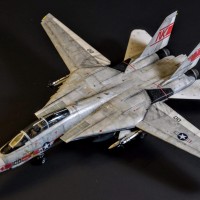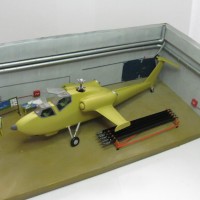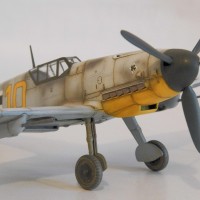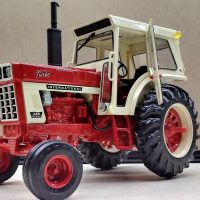Promodeler 1/48 P-47N Thunderbolt
Here in the U.S. it is turkey day (Thanksgiving) and with this day, there is typically a baked turkey covered with a foil tent. But another bird is seeing the light of day today, namely an aluminum foil covered P-47.
I have been working on ProModeler's 1/48 P-47N Thunderbolt for several months. I would like to offer it up today for viewing. You can see details of the build in my group build thread at https://imodeler.com/groups/the-80th-anniversary-of-the-attack-on-pearl-harbor/forum/topic/shake-and-bake-pacific-jug/
This aircraft served in the Pacific Theater late in the war. By this time, most US Army Air Force aircraft were left un-camouflaged in their natural aluminum metal, only applying paint for markings and identification purposes. Within the squadrons, the aircraft were further decorated by the pilots, ground crew, and sometimes by squadron orders. The P-47N is a larger winged, more capable version of the Thunderbolt line of fighters. It is an impressive looking aircraft, even more so because of the wider track of its landing gear and the increased wing area. Add these to the natural metal, and the splash of color added to most aircraft, and you have a very interesting subject for a model build. I wanted to replicate this look.
This aircraft served in the Pacific Theater late in the war. By this time, most US Army Air Force aircraft were left un-camouflaged in their natural aluminum metal, only applying paint for markings and identification purposes. Within the squadrons, the aircraft were further decorated by the pilots, ground crew, and sometimes by squadron orders. The P-47N is a larger winged, more capable version of the Thunderbolt line of fighters. It is an impressive looking aircraft, even more so because of the wider track of its landing gear and the increased wing area. Add these to the natural metal, and the splash of color added to most aircraft, and you have a very interesting subject for a model build. I wanted to replicate this look.The Kit And Aftermarket Items
This project used the ProModeler 1/48 scale P-47N Thunderbolt kit. I had purchased this kit for my stash prior to my knowledge of the Academy kit. From what I know of that kit, it fits somewhat better than the ProModeler kit, has superior surface detailing (mostly), but has some areas which are less detailed. Not having the Academy kit to compare to, I cannot say for sure.
The Promodeler kit is typical of 1990s era models, improved detailing over previous generations of kits, although it does have fit problems, and some areas of the surface detailing are poorly executed. The cockpit is not bad, but could use improvements. Other areas, such as the wheels and the gun barrels would also benefit from replacement.
For these improvements, I purchased Eduard’s SPACE 3D printed cockpit details, Master brass gun barrels, and Ultracast main wheels. All of these were designed for the Academy kit, but I was confident I could make them work on this kit. I also purchased an Engine And Things R-2800 engine to replace the kit molded engine, thinking that it should have been better, however, it was poorly cast and was generally inferior to the kit part, so was not used.
I wanted to use a scheme different from kit supplied markings. I was also concerned about the age of the kit decals so I purchased Kits World decals. These too, were designed for the Academy kit, but presented few problems during application. And to wrap things up, I purchased canopy masks. However, these did not fit the Promodeler kit and were not used for painting. Live and learn.
In order to accomplish the foiling, I first spent time learning the technique from what other modelers have done. The Internet is a great resource for this sort of learning, and I took full advantage of it. I won’t go into details here, but direct you to the build thread for more information.Cockpit Work
As mentioned previously, the cockpit of this kit is adequate, but I wanted to improve it with aftermarket parts. Since the Eduard SPACE set is designed for the Academy kit, some modifications would be needed. For example, the instrument panel in the Academy kit, and the associated Eduard part are somewhat different than the Promodeler Kit. I ended up using the SPACE 3D parts as tracing templates to recreate the instrument panel out of sheet styrene. I also had to slightly modify both the kit sidewalls and the 3D printed pieces to fit each other.
The kit seat is poorly executed, but with some modification, namely the improvement of the support structure on the backside of the seat using styrene rod, an acceptable seat was possible. Adding the SPACE 3D seat belt harness helped considerably with this.
Fit of the cockpit into the fuselage is very iffy. ProModeler would have you insert this part after assembling the fuselage halves but I wasn’t comfortable with this idea, given the lack of positive location in this area. I added bits of styrene to provide better location guidance and glued the cockpit in one half before assembling the fuselage.
I had read that the cockpit interior color of the P-47 was a bronze green color rather than the normal interior green. I tried to use AK Bronze Green for this but I feel that the color is off. However, at the time, I was more interested in getting to the foiling work and elected to leave it as it was. So you will see that it looks too green in the photos. Not terrible, but probably incorrect.
Other painting work was accomplished using Tamiya acrylics (for spraying) and Vallejo acrylics (for brushing). The areas were given a clear coat and wash to add to the shadow areas, then lightly dry brushed.Fuselage Assembly, Seam Work, And Exterior Detail Correction
In general the fit of the two fuselage pieces was pretty good, only requiring a minimum amount of filling of seams. I used my normal process of precision filling using black cyanoacrylate glue (CA) and a piece of wire, followed by accelerator and then sanding using various progressively finer grits of sanding sticks.
Surface detail that was acceptable as molded, was restored in the sanding areas using a razor saw or scribing needle or palm press embossing tool with various pressing bit sizes. Unfortunately, some areas of the surface detailing were poorly executed during the mold making process, resulting in detail that looked pretty bad. One area in particular, a curved panel line on the belly, looked as if it were made with a shovel on one side of the fuselage while the other side was more properly executed.
These types of details were, by necessity, in need of clean up and correction. There were also a few incomplete panel lines making a panel look like it was incomplete. And some panel lines were very shallow. All of these were corrected before beginning the foil work. All detail restoration went through the normal post work process of light sanding to remove burrs, brushing with an old toothbrush to remove dust, and then a light application of Tamiya Extra Thin Cement to soften the panel lines to match surrounding areas.
The model has the exhaust openings forward of the tail wheel well molded closed, or more accurately with no opening molded in. So I took the time to cut this area out , thin the plastic at the edges and add a center support piece. Similar work was accomplished later, for the same sort of problem, on the exhaust gates behind the cowling. Foiling Work
I started on this by foiling relatively flat areas on the sides of the fuselage. This gave me some experience with burnishing, pressing the foil into panel lines, judging how big of pieces of foil I could work with, the adhesive application process itself, and cutting the foil along panel lines. I also used the side openings on the fuselage ( I am not sure what these are called) to get some practice in conforming the foil to irregular surfaces. Again, rather than getting into the details, I would direct you to the build thread. But suffice to say, this process of foiling the entire aircraft took several weeks to complete.
The wings required some additional work in regards to the landing gear because the gear struts and wheel wells are all one piece, necessitating the struts be installed early in the build. I wasn’t going to deal with fighting those struts during subsequent operations, so they were cut off, to be glued on later. See the build thread for more on this. Wings were installed before completing the foiling work. Some areas gave me quite a bit of trouble, but in the end, I got most of them covered. Only the wing tips and ailerons were painted with Alclad.
Subassemblies
From past experience, I know that leaving smaller sub assemblies, like landing gear and propellers, to later in the build , generally results in rushing through these, sometimes with less than desirable results. So I decided to complete most of these next before moving on to the final finishing work on the model.
I needed to get the engine assembled and installed so I could install the cowling. While working on the engine and waiting on paint or glue, I would foil the cowling. It was foiled in small sections, most of which were easy enough to do. The leading edges were more difficult, and I had to redo one of them. I found that by cutting the foil close to where its final edge would be, considerably eased the transition and burnishing around the curves of the cowling leading edges.
As for the engine, this is where I determined that the Engine And Things engine was not going to be usable. After looking at the kit engine, I decided that it was detailed well enough, even having spark plug wires molded in place. This was assembled, painted with Mr Color Super Metallic Stainless Steel 2, then given a black brown oil wash. All detail painting was done with Vallejo acrylics. I did have to do some sink mark filling on the inside of the cowling and the lower intake duct for the cowling.
The landing gear doors were also painted and foiled at this time. I neglected to mention earlier, that the inside gear doors were also mold integrally with the gear wells and had to be cut away for installation later. The strut doors were separate pieces. The tail wheel well piece had the doors molded in the open position and this was painted and outer surfaces of the doors foiled.
The drop tanks on this kit are fairly well detailed, but fit is only fair. They were assembled and cleaned up. I used photo etched filler caps to dress them up a bit. The pylons themselves were nicely detailed and left as is. I wasn’t even going to attempt to foil the drop tanks, and these were painted with Alclad Airframe Aluminum, then given an oil wash.
The Ultracast wheels were fitted but not installed yet, then painted. These are quite well detailed, even having the valve stems on the wheels. Weathering was accomplished using a combination of washes and pigments. The tail wheel & strut is one piece and was cleaned up and painted. It would be added to the tail wheel well assembly later.
I was not adding the wing rockets to this kit, so they were not worked on. The propeller is nice looking and only required cleaning up , then painting. This was done with a combination of Tamiya colors (semi gloss black, rubber black, and flat yellow) and Alclad Airframe Aluminum for the spinner.
Painting and Weathering
Having never foiled a model before, I was unsure what was going to look the best after painting. I was initially very reluctant to sand the foil, even after testing on a mule. I kept looking at the foil work and liking the metallic look. But I knew that I was really just letting fear of trying get in the way. After all, it is only a model.
The act of burnishing the foil had left some scratches and marks on the foil, which for the most part didn’t distract from the overall effect, but the foil was far too shiny in many places and I was after a weathered aluminum bird, not a show plane.
My experimentation on the mule had shown that using the 3000 grit Tamiya sanding sponge ultimately gave the best result, but my supply of this was limited and testing had also shown that the sanding grit wore out quite quickly. Using the extra no name brand 3000 grit sponge prior to using the Tamiya sponge solved this problem.
Painting on this scheme is limited to a yellow tail and stripes on the wings as well as an olive drab anti glare area on the fuselage spine. All of this required various degrees of masking, being careful to avoid pulling the foil off when de-masking.
Decals went down with little drama other than some of the kit decals cracking and being unusable. Weathering was accomplished using oil paints for panel line washes, and some panel lightening (by using a very thin application of white). The decals were also given this treatment. Some general dirtying up was done using various brown and black oil mixtures.
The entire model was given a coat of VMS Satin Varnish which dulled down the foil. I admit, this was another process where I was initially reluctant to do, but went ahead and did it anyway. It looks fine to me, so I guess in the end, that’s what is important.Final Assembly
Getting all the final bits installed was a process of waiting mostly, inter spaced with a few purple clouds floating overhead. Because I had previously cut the landing gear legs, I wanted to epoxy them back together. Given the extended drying time of epoxy, it took an hour of constant adjusting the landing gear legs to keep them aligned and in the correct position. I even let the epoxy cure a bit after mixing before using it. I had to wait a full day before I felt comfortable enough to rest the model on its legs. Then I had to glue on the resin wheels. These were also epoxied and the waiting process (with associated adjustments) was repeated.
The gear doors were glued with CA glue so that went easier, although they were somewhat fiddly and had to be trimmed a minor amount to fit properly. The drop tanks were an entirely different experience however. The kit pylons fit poorly against the wings and required quite a bit of adjustment. Thick super glue failed to work here and in the end, they had to be epoxied as well, again with waiting and adjustment. The propeller went on with no problem as did the tail wheel. The canopy was easily installed, secured in place using Micro Crystal Clear Glue.
Then came the brass wing guns. I had already previously tested these in the openings on the wing leading edge, but there was enough foil and paint in the area (mostly clear coat), that they would not easily fit into the holes. On top of that, they needed to be placed the correct distances into the wings, and kept level with one another.
I clamped two popsicle sticks to the wings to aid with this placement, marking the insertion distances on the sticks as well as alignment lines. This was all rather fiddly. When I started trying to place the barrels in the holes, they would not go in easily. I got the shortest extended barrel in the starboard wing first, but in the process of trying to place the second starboard gun barrel in place, I managed to push the first one flush with the wing. No amount of trying was able to pull it out again, and in fact it eventually fell into the wing, with no hope of retrieval.
After that, I decided to drill the holes in the wing to clean them out, but the drilling process left the openings slightly bigger than the barrels, meaning that they would not stay in position easily. So I was forced to try and hold them straight, and in the correct extension , and parallel to the other barrels, while applying CA glue. Needless to say, purple clouds, lightning, and thunder was a part of that experience.
The port wing also suffered the shortest barrel falling into the wing. Fortunately, I have some brass tubing, which while slightly smaller in diameter, is not too noticeable and I was able to replace those two short barrels. Next time I do something like this, I am going to find a way to improve my odds of getting through this without frustration.
The only remaining thing to do was fix the broken antenna (yes I managed to snap it off), and add the other two fuselage spine antennas. These were touched up with Alclad and the project was completed.
So I hope you all enjoy this article and accompanying pictures.
















Not sure why but this is not letting me format some of the text properly!
A wonderful result, Carl!
Loved following your build thread.
Congratulations!
Thanks Spiros (@fiveten). It was my pleasure to share the project. And I appreciate the visits and encouragement along the way.
Absolutely amazong work!
Thanks Bernard (@lis). It turned out better than I thought it would and is a satisfying thing to have done.
I really like the alu foil finish. Very convincing NMF bird! Awesome job.
Thanks Alfred (@alfred). It is amazing to me that it is possible to get a natural look using fairly simple techniques.
Thanks everyone else that has viewed and left feedback.
Looks great, Carl (@clipper). I think the foiling is a work of art, and your results speak for themselves. It was a pleasure following along on this build. Earlier, I had trouble getting photos to go into my Headlines piece. It took 2 hours to get the photos to save with the article. Happy Thanksgiving.
Thanks George (@gblair). I am not sure what happened with the article. I prepared it outside of Imodeler and then copied it and pasted it into the article when I created it. But I could not get it to format properly. I did have issues with the photos at first, but on the second try they were uploaded correctly.
What an excellent result, Carl @clipper
I'm really impressed with the way you applied the foil and make it look this realistic.
It was great to be able to follow your process of getting this foil on in the thread, thanks for showing.
Hope you had a wonderful Thanksgiving.
Thanks John (@johnb), it was an interesting diversion from the normal approach to finishing and one that I will probably do again someday. Certainly, the ability to apply thin aluminum to the surface of the model, even if for just a panel, will have useful applications at some point, giving me the ability to replicate overlapping or raised paneling. I do want to reiterate that I was only confident enough to do this because of learning from others who have gone before me.
That is one good-looking Jug!
Thanks Greg (@gkittinger)!
G’day Carl (@clipper),
I was skeptical about the use of aluminium foil vs painting at first, but you have done a masterful job.
Liked!
Thanks Michael (@michaelt). The nice thing about modeling is we can try these sort of things out, regardless if they work or not. I figured, I really had nothing to lose and I really wanted to try foiling anyway. 🙂
This is a great article and a wonderful model to enjoy, Carl @clipper! 👏 I learned a great deal from your adventures with the foil. 👍 On a couple of occasions when I was going to place gun barrels into wing leading edges, I fabricated and glued a simple "barrier" inside the wing before the halves are assembled that served as a "stop" for the barrels. Getting eight of them lined up straight in both orientations has to be tough but you handled it well! 😃
Thanks Gary (@garybrantley). I had originally planned on making the stop you mentioned, and I should have, but at the time I made the decision to close the wings, the barrels fit tightly enough i the holes that I felt I could get away without doing so. That was a mistake. I think the ideal way to do this is to create not only a stop, but have larger barrels that sit flush to the wings and which the final display barrels slide into. This solves the orientation problem and the stop can be devised so that the amount of slide in can be controlled. Ah well, I guess next time! 🙂
I believe you're right about that method, Carl. I tried something similar on my Tamiya Wildcat, although the gun barrels don't protrude like a Thunderbolt's do. Problem solving is one of the "fun" aspects of our hobby; would we enjoy it as much if everything went right all the time? Hmmm...on second thought, maybe we'd enjoy it a lot more! 😁
Then, build on! 😊
Well I for one, Gary (@garybrantley), would be a whole lot happier if the stupid parts would quite falling on the floor or tape sticking to my fingers but refusing to stick to the parts I am trying to hold with it!
😄 I'm getting awfully tired of bending down to pick up my tweezers, which I've dropped while trying to pick up a tiny part...🙄
That's a good looking build! Thanks for sharing.
Rod
Thanks Rod (@rodbettencourt)! It was my pleasure.
Very nicely done Sir!
Thanks Butch (@butchbryan)! Hopefully someone else might feel the desire to try this approach to natural metal finishes, even if only one time.